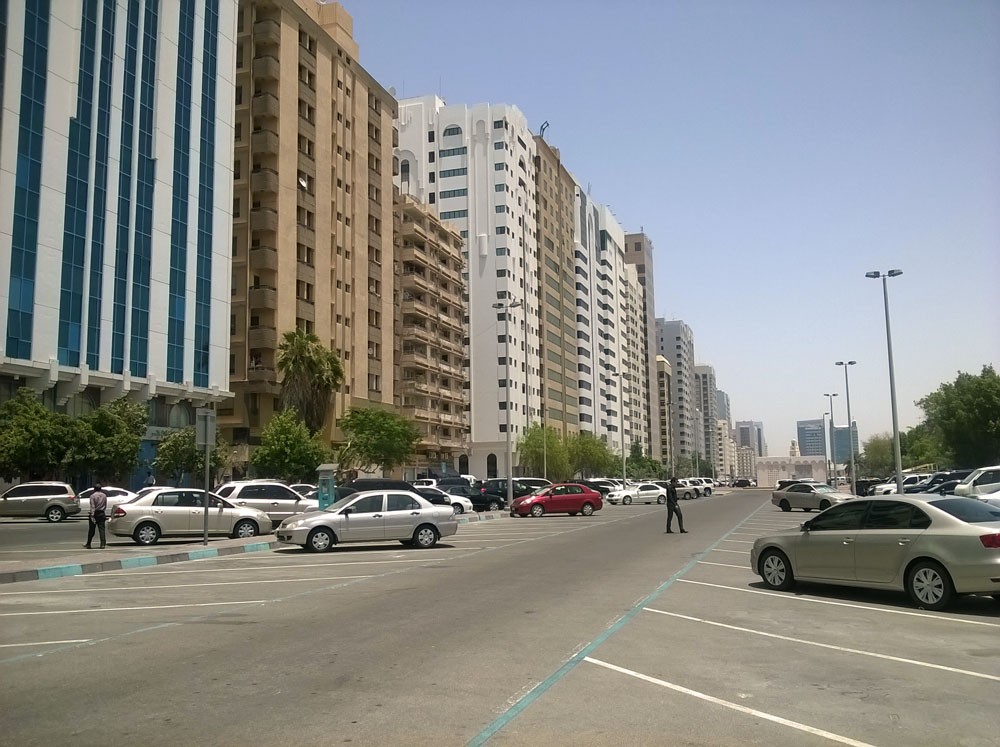
Imagining a more walkable Abu Dhabi
In June, I spent a couple weeks travelling around the United Arab Emirates and Oman. Of course, Dubai is far and away the poster child of the region, with its gee-whiz projects like The World and the 209-storey Burj Khalifa — but neighbourhing Abu Dhabi, where I spent most of my time, is just as ambitious, if less flashy. In fact, the whole country (made up of 7 semi-autonomous Emirates, each with its own ruling Sheikh) is soaked in oil wealth and foreign investment, which the Sheihks spend with varying degrees of extravagance.
To infinity and beyond
Having sprung up out of the desert in the mid-1900s, Abu Dhabi has grown at an astronomical pace and isn’t slowing down. Its main island is more or less built out. Master plans for the neighbouring Al Reem island and Saadiyat island are going full steam ahead. But at the same time, the city has entered the second life cycle of its infrastructure. Sooner or later, Abu Dhabi will have to divert its energies away from chasing the Next Big Thing and invest in maintaining its existing neighbourhoods.
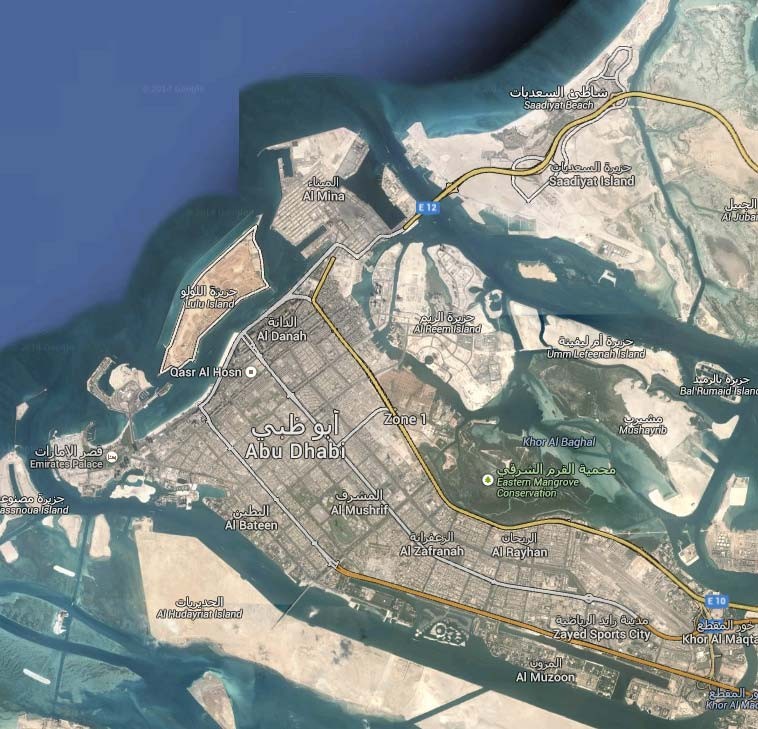
Unsurprisingly, restraint and maintenance are the last things people want to talk about here. Abu Dhabi is not content to stop at the status quo. Everyone I met had a glimmer in their eye about the city’s future. Checking into a hotel, the concierge exhorted me to visit the newly-built Sheikh Zayed Grand Mosque. “It’s a world wonder! Ten stars! People will be coming from all over to see it!”
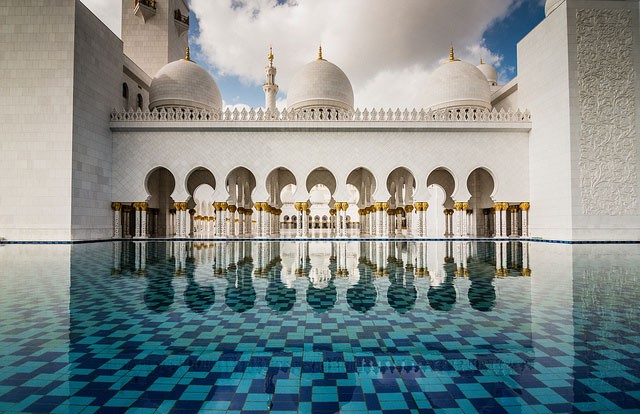
This is a city relentlessly looking forward. Once-decent apartments built in the 80s are being demolished — too short, too old, out of fashion. Why restore and upgrade outdated infrastructure when you can build a new gleaming steel-and-glass masterpiece in its place?
Even the old medina has been razed and forgotten. In its place stands Abu Dhabi’s World Trade Center. Of course, they’ve incorporated a contemporary souk to honour the traditional market: roomy, air-conditioned, with all the old-world charm of a theme park.
High curbs and wide roads
For such an ambitious place, Abu Dhabi (like the other Emirates) has taken quite a lax approach to active transportation. Walking and cycling is not just inconvenient, but often downright impossible. When I first arrived at the central bus terminal in Abu Dhabi, my destination was only two blocks away. I figured it wouldn’t be too difficult to walk, despite the 40-degree weather and a suitcase to pull.
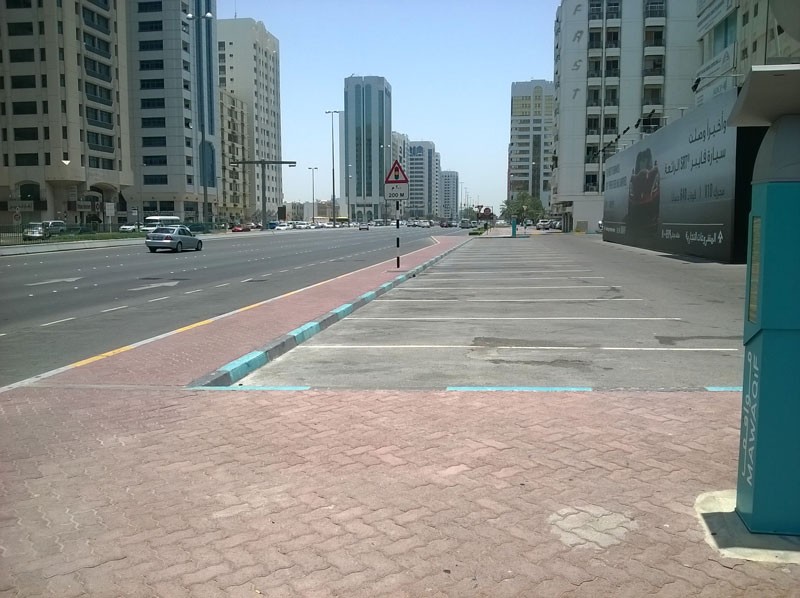
Boy, was I wrong. Sidewalks and pedestrian crossings are an afterthought, if included at all. Curb cuts are almost non-existent, so people with strollers, wheelchairs, luggage, or carts simply can’t get around safely. Sidewalks zigzag at ninety-degree angles to accommodate parking stalls. If you’re not travelling on four wheels in Abu Dhabi, you are indeed a second-class citizen.
Abu Dhabi is planned along a strong grid pattern, with four-lane urban highways slicing the city up into neighbourhood units. These major roads usually have a landscaped median with fences, making jaywalking and mid-block left turns impossible. Many car trips start by heading in the wrong direction until you can make a u-turn.
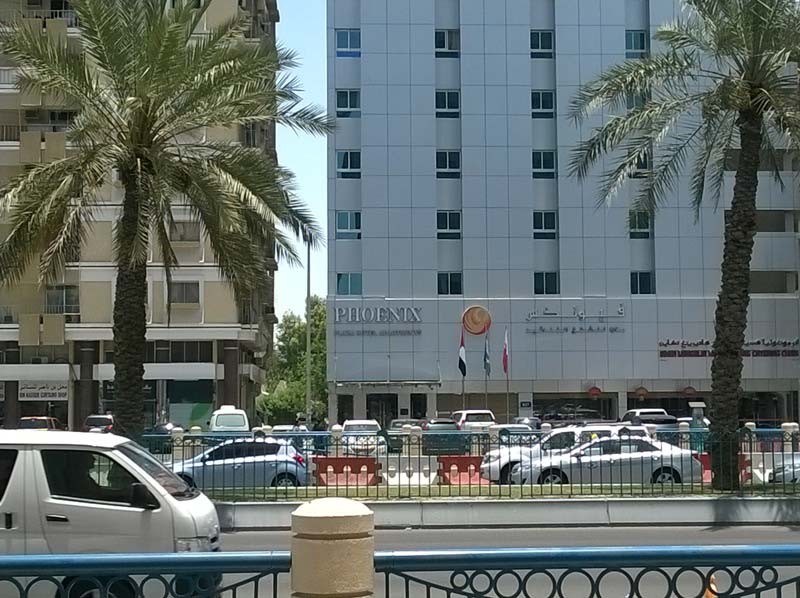
Within the neighbourhood units, though, communities are surprisingly complete. In the places I visited, there were all sorts of independent businesses on the ground floors of every building. Supermarkets, restaurants, bakeries, tailors, laundry services, hair salons, doctors’ offices, housewares stores, even the odd karaoke bar or covert nightclub. Each neighbourhood certainly had a mosque. All that’s missing are schools within walking distance.
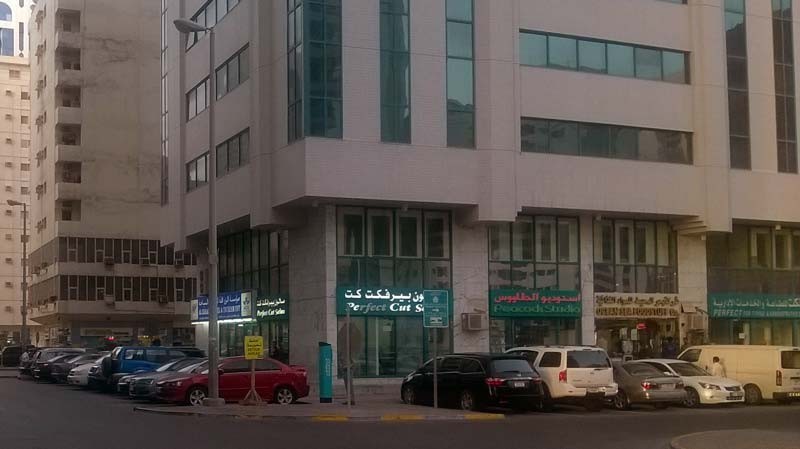
The bones of livability
These neighbourhoods are dense, with almost everything you need for day-to-day life — that’s two points on the urbanist scorecard. But I wouldn’t say they are walkable. Why not? Let’s take a look at some aerial photos of the Tourist Club neighbourhood. Despite the name, it’s not a haven for tourists; just a working-class neighbourhood nestled between Abu Dhabi’s emerging financial district and the beachfront Corniche area.
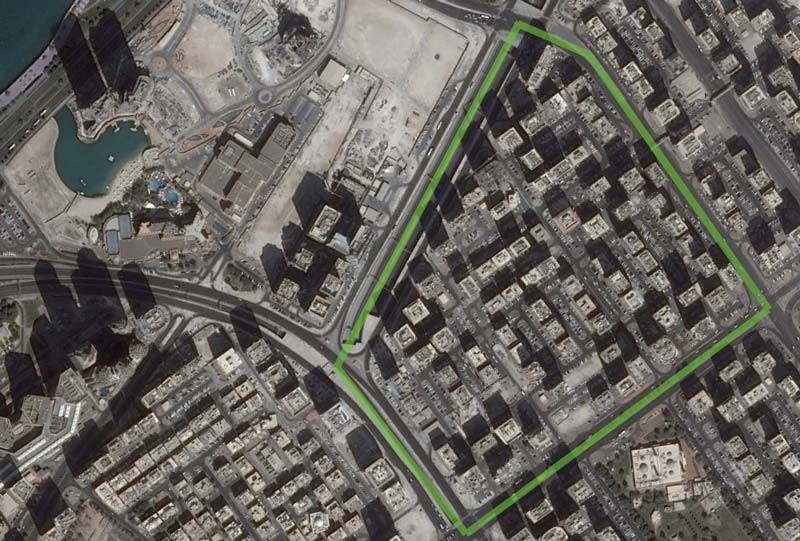
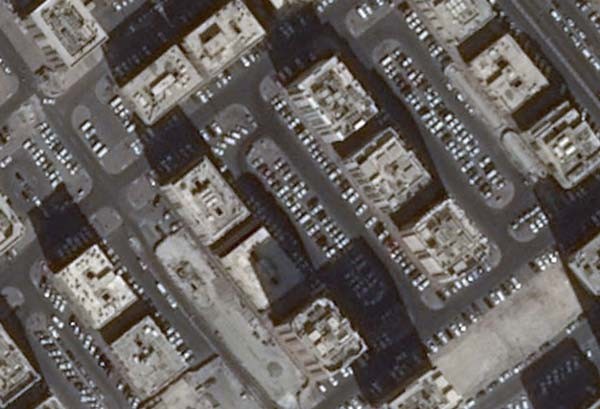
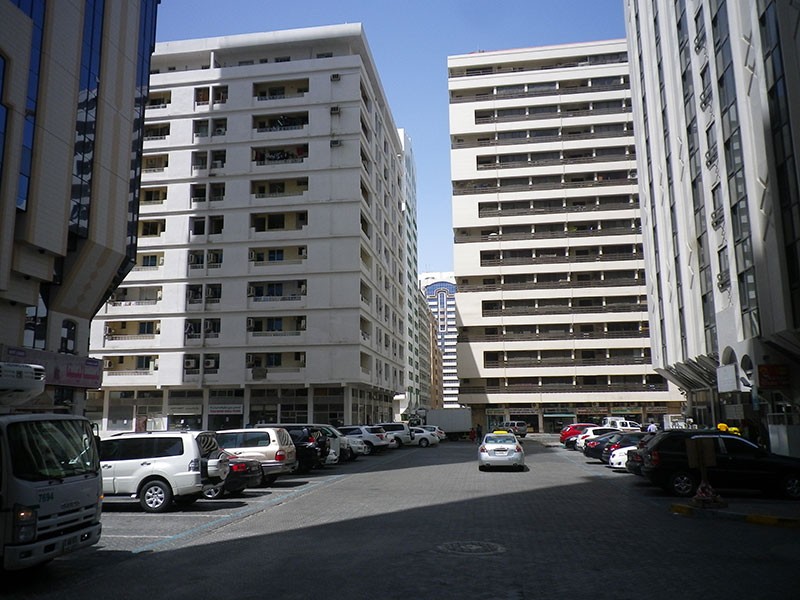
I call this “towers in the parking lot”. It’s a shame that the area feels so hostile on foot, because you’ve got all this mixed-use density, you’ve got buildings in a more-or-less grid pattern, but what fills the spaces between them? A parking lot with little regard for active transportation. Sidewalks hug the edges of each building, but there is no connectivity for pedestrians to move around the neighbourhood comfortably.
Abu Dhabi’s Walking and Cycling Master Plan
It’s with great interest, then, that I came across Abu Dhabi’s recently-announced Walking and Cycling Master Plan. Could it be that they’ve got a plan in motion to address this issue?
The Plan starts with some strong rhetoric, declaring that “walking and cycling will be accessible, safe, convenient and enjoyable for all.” Among the challenges to a walkable city, it lists “Car oriented urban areas – large blocks, very wide streets with very fast traffic, huge parking lots and unorganized parking.” ()
The Safety section says, “The urban environment will be safer and more accessible, no longer dominated by motor vehicles at the expense of all other users.”
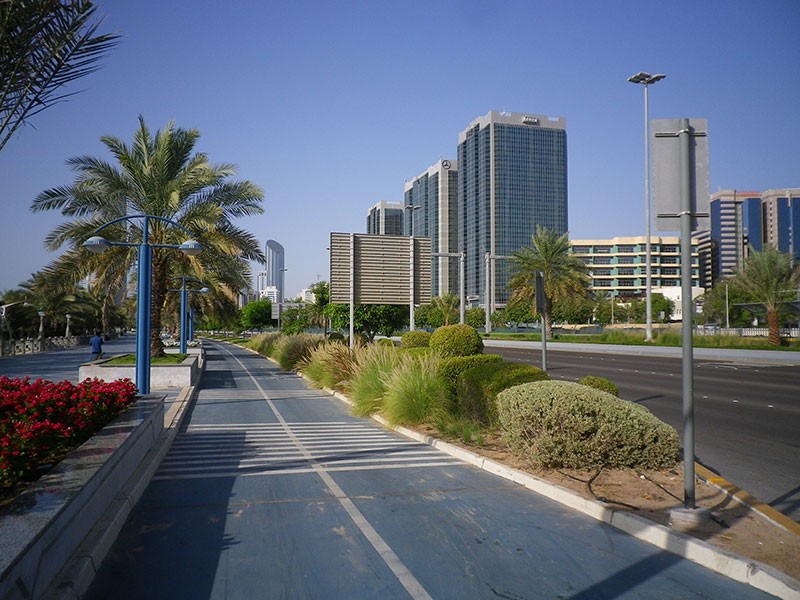
All good policy. Abu Dhabi clearly recognises the problems with car-dominant cities and wants to do something about it. So how do they plan on getting there?
Achieving broad and far reaching change inevitably draws on multiple stakeholders, necessitating involvement and close collaboration across a number of sectors – transport, police, health, industry, civil society and special interest groups. To have the greatest impact, it is essential that comprehensive institutional buy-in is achieved so a coordinated response can be effectively delivered. — WCMP Highlights, page 18
Re-read that last bit. Comprehensive institutional buy-in: this approach excludes incremental, lighter-quicker-cheaper interventions at the local level. Instead, the Emirate’s way forward is to garner everyone’s support for the already-finalised Master Plan, which the relevant authorities will fund, coordinate, and effectively deliver.
Unfortunately, the Master Plan says nothing about retrofitting the “towers in the parking lot” phenomenon in neighbourhoods like Tourist Club. Either the Planners aren’t aware that it’s a walkability nightmare, or it’s just not a priority.
And if neighbourhoods acted on their own?
Hypothetically, then, what could happen if neighbourhoods — say, under the structure of local Business Improvement Areas (BIAs) or property owners’ associations — were given the authority to plan, fund, and implement their own solutions?
What if instead of lilypads among a sea of parking, the buildings in Tourist Club were connected by proper walkways?
What if a parking structure — generating revenue for the local BIA — freed up some of that scarce asphalt for a basketball court?
What if restaurants and cafes had enough sidewalk space for patio seating?
Maybe Tourist Club could look a little more like this:
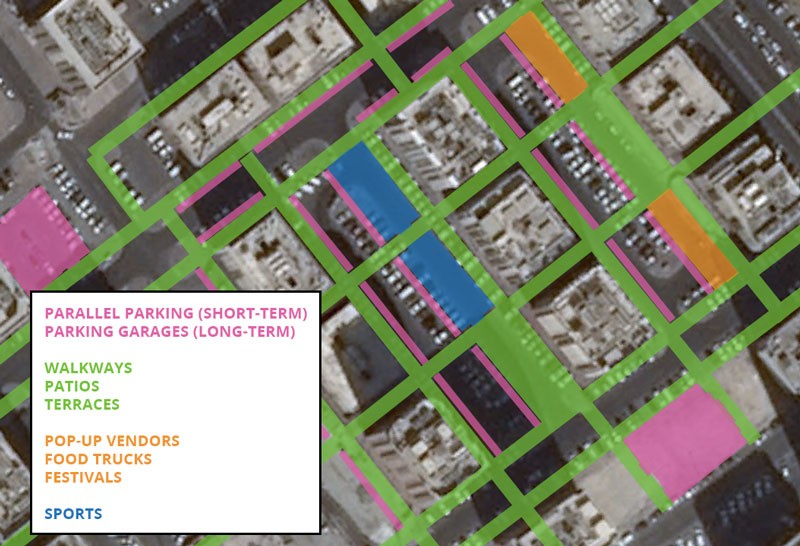
Or maybe it would look completely different. And that’s okay. But if Abu Dhabi is going to maintain a resilient urban core, it can’t ignore the infrastructure improvements needed within neighbourhood units. Maybe the neighbourhoods themselves are the best entities to carry out this work, since high-level government seems ever-focused on the big and shiny and new.
“Towers in the parking lot” have no place in a walkable city. So if the Walking and Cycling Master Plan won’t do anything directly to reverse this destructive pattern, local-level associations should be empowered to take the reins.
It’s hard to believe that radical local empowerment could happen in an authoritarian monarchy… but I prefer to sell it as another leap forward for Abu Dhabi’s ever-ambitious society.
Sam Nabi
Comments
Excellent! In my 3 months here I have seen people regularly walk or cycle. Your plan would encourage them and yes why not empower local business to innovate?
Sam, as usual, fascinating. And depressing. One of the problems, I suppose, is convincing people that they want to walk in that heat. Covered walkways would be a must.
Post a comment